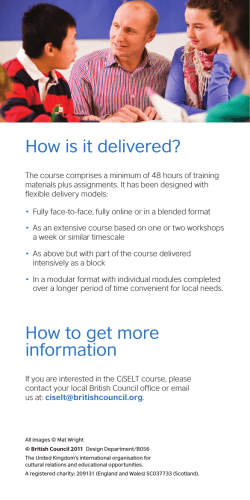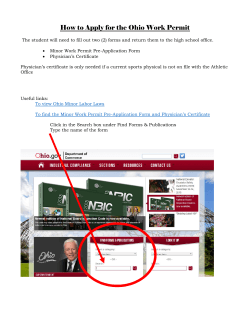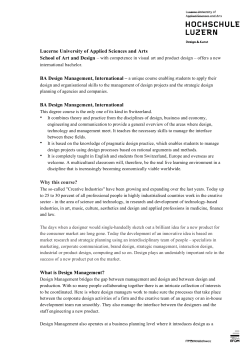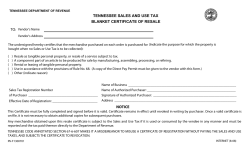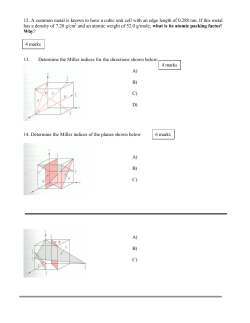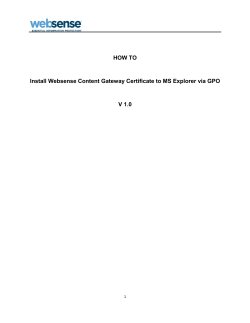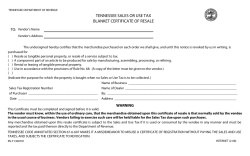
IT4BI-DC Application Manual V 2.1 2013 1
IT4BI-DC Application Manual V 2.1 2013 1 Contents 1 Presentation & Structure 3 2 Eligible applicants 6 3 Application periods 8 4 Registering to the System 9 5 Application procedure 5.1 Filling in Application Form . . 5.1.1 Personal details . . . . . 5.1.2 Academic qualifications . 5.1.3 References . . . . . . . . 5.1.4 Work experience . . . . 5.1.5 Language skills . . . . . 5.1.6 Publications . . . . . . . 5.2 Uploading Attachments . . . . . 5.2.1 Mandatory Attachments 5.2.2 Optional Attachments . 5.3 Submitting Application Form . 5.4 Submitting Paper Documents . . . . . . . . . . . . . . . . . . . . . . . . . . . . . . . . . . . . . . . . . . . . . . . . . . . . . . . . . . . . . . . . . . . . . . . . . A Calculation details for title self-evaluating 2 . . . . . . . . . . . . . . . . . . . . . . . . . . . . . . . . . . . . . . . . . . . . . . . . . . . . . . . . . . . . . . . . . . . . . . . . . . . . . . . . . . . . . . . . . . . . . . . . . . . . . . . . . . . . . . . . . . . . . . . . . . . . . . . . . . . . 10 10 11 12 20 23 24 27 29 29 31 33 34 36 1 Presentation & Structure The program favors the integration of students into a network of specialists and researchers in BI. The curriculum is jointly delivered by Universite Libre de Bruxelles (ULB) in Belgium, Aalborg Universitet (AAU) in Denmark, Technische Universitat Dresden (TUD) in Germany, Universidad Politecnica de Catalunya (UPC) in Spain, and Poznan University of Technology (PUT) in Poland. Scholars from academic partners around the world and partners from leading industries in BI, private R&D companies, service companies, public research institutes, and public authorities will contribute to the program by training students, providing computers, software, course material, job placement or internship perspectives, as well as financial support. This consortium will prepare the students not only to answer today’s professional challenges by a strong connection with the needs coming from the industry, but also with the researchers’ and innovators’ views. Figure 1: Doctoral program structure All IT4BI-DC candidates will follow a programme with the same structure, regardless of the academic institutions that provide the degree. This is ensured by a jointly designed IT4BI-DC doctoral process (see figure above). Each candidate will be involved on a research topic proposed by two institutions (i.e., home and host). The Doctorate thesis will be co-supervised by two professors, one from each of the proponent institutions using a cotutelle model. All IT4BI-DC partners have extensive experience in doctorate co-tutelle arrangements. During the first two months after enrolment, the candidate together with 3 his/her co-advisors will draft a Doctoral Project Plan (DPP), which formulates and concretises the elements involved in the research process. In addition, the DPP will specify the candidate’s personalised education and training programme taking into account his/her previous background and future career prospects. It also specifies the expected mobility periods at the host university. With respect to mobility, candidates start the first year at their home university, spend (a part of) the second year at their host university, and return for the third year to their home university. Further, shorter stays at the host university are planned during the first and third years. Thus, Doctoral candidates will spend at least 33% of their doctorate at their host university, divided in three visits (two short visits will be at least 1 month, and a longer one at least 6 months). Figure 2: Research challenges Three milestones are planned in the programme: M1, at the end of the first year, candidates present a Thesis Proposal Report (TPR, extension of the DPP); M2, at the end of the second year, candidates present a Research Progress Report, including a description of the main issues, early research results, and plan for the remaining work; and M3, at the end of the third 4 year, candidates submit their Doctoral Thesis. Notice that the doctoral programme includes the participation to the European Business Intelligence Summer School (eBISS) organized by the Erasmus Mundus Master course IT4BI and the Doctoral Colloquium organized by IT4BI-DC. The research agenda of the IT4BI-DC programme is articulated around the following Business Intelligence challenges each one studied at different centers. 5 2 Eligible applicants • Students from all countries can apply to the IT4BI-DC Joint Doctorate Programme. • Students must have been awarded the equivalent of 300 ECTS of studies with a major in computer science, from an accredited university (listed in the IAU’s List of Universities of the World1 or in some of three top university rankings Shanghai2 , QS3 and Times4 ). At least, 60 of those ECTS must correspond to a Master’s degree. • In the case that the applicant has not yet obtained his/her master degree at the time of application deadline, he/she may nevertheless apply to the program. In this case, if he/she is accepted, the acceptance will be conditional. • Students applying for a scholarship must upload proof of obtained master degree no later than the dates specified on the page: http://it4bi-dc.ulb.ac.be/apply. • Non-native English Students must be able to demonstrate proficiency in English by means of an internationally recognized test (see Section 5.1.5 - Table 1) equivalent to level C1 in the CEFR (Common European Framework of Reference for Languages) or with the proof that they have followed at least one of the previous level(s) of studies in English. • Be aware that you can apply to more than one Erasmus Mundus scholarships, but no more than three. If you apply to more than three Erasmus Mundus scholarships you will be automatically excluded from all of them. • Two different Erasmus Mundus Doctorate fellowships are available: – Category B fellowships are available for: ∗ Students who are nationals of one of the 28 EU Member States: Germany, Austria, Belgium, Croatia, Denmark, Spain, Finland, France, Greece, Ireland, Slovakia, Slovenia, Italy, 1 The complete list of recognized institutions can be found at: http://www.iau-aiu.net/sites/all/files/df_nw.pdf 2 http://www.shanghairanking.com/ 3 http://www.topuniversities.com/university-rankings/world-university-rankings/ 4 http://www.timeshighereducation.co.uk/world-university-rankings/2011-2012/top-400.html 6 Luxembourg, the Netherlands, Portugal, UK, Sweden, Bulgaria, Malta, Poland, Czech Republic, Cyprus, Estonia, Hungary, Latvia, Lithuania, and Romania. ∗ Students who are nationals of one of the EEA-EFTA states: Iceland, Liechtenstein and Norway. ∗ Specifically, Switzerland and Turkey are not eligible applicant countries. ∗ Students who have resided or carried out their main activities (studies, work, etc.) for more than 12 months over the past five years (counted backward starting from February 28th, 2014) in any of the above listed countries. – Category A fellowships are available to all other candidates. Note: • Third-country doctoral candidates who have previously received an Erasmus Mundus masters scholarship, can be awarded a Category A fellowship. • Doctoral candidates benefiting for an EMJD fellowship cannot benefit from other Community grants while carrying out their Erasmus Mundus doctoral activities. • For Category B fellowship holders, the IT4BI-DC universities of the co-tutelle must not be located in the country in which the doctoral candidate has obtained his/her last university degree. • Application for either of the two previous categories does not require paying of any application fee. The only possible cost is that of the paper document submission, and can vary from the chosen mailing service. 7 3 Application periods Please take into account that there are three different application periods considering different types of you application (scholarship/fee paying) and your nationality (EU/non-EU students): 1. All candidates (EU or non-EU) applying for the scholarship (Categories A or B - see Section 2). 2. Non-EU candidates applying as fee paying students. 3. EU candidates applying as fee paying students. Note: The deadlines/important dates for all three application periods are available at the program’s web page: http://it4bi-dc.ulb.ac.be/apply 8 4 Registering to the System Prior the beginning of the application procedure, you first need to register to the IT4BI-DC online application page using your internet browser5 . • http://it4bi-dc.ulb.ac.be/emundus/ Figure 3: IT4BI-DC Registration Form All fields are required in the registration form and they should be filled as follows: • First Name: First (Given) name of the candidate • Surname: Last (Family) name of the candidate • E-mail: E-mail of the candidate • Username: Username for logging in the system • Password: Password for logging in the system (at least 4-characters long) After submitting the form for registration, you will receive an e-mail containing your personal data, along with the necessary login information and link for the confirmation of your e-mail address. 5 Please use Mozilla Firefox or Google Chrome browsers for the full functionality of the application web page. 9 Figure 4: E-mail address confirmation 5 Application procedure Application for the IT4BI-DC Erasmus Mundus program consists of the following four mandatory steps: 1. Filling in Application Form 2. Uploading Attachments 3. Submitting Application Form 4. Submitting Paper Documents 5.1 Filling in Application Form Figure 5: Status of the application prior the beginning of the application procedure 10 The application procedure starts by filling in the online application form. The form consists of the following sections (forms). After filling each form, you need to confirm it by pressing ” Save & Continue” button. 5.1.1 Personal details This form consists of personal details information (Sex, Birth date, Nationality, Contact address, Mobile phone number). All fields are mandatory. Note: Please include full prefix with the country code for the mobile phone number. Along with that, the form also requires you to prioritize your preferences for the research challenges and topics (see Figure 2) by ranking at most six different research challenges and choosing the topic for each ranked challenge. Note: Each research challenge is coordinated by one of the centers of the Doctorate program, except Challenge 6: Collaboration and Privacy that is traversal to all centers. Accordingly, the applicants are distributed in the centers of the choices considering their rankings and preferences. For example, the applicant has ranked only a subset of the challenges (three challenges). It may happen the case that the places in the first two centers of the ranked challenges are already filled with the higher ranked applicants, so the applicant would be assigned to the third center. However, if all three centers of the ranked challenges are filled with the higher ranked applicants, the applicant will be excluded from the admission process. Also, if the applicant is actually assigned to one of the centers of choice, they are required to study in that center. 11 Candidates with any kind of disability or need can shortly (absolutely confidentially) describe it, only for the purpose of positive discrimination during the evaluation procedure. Finally, the candidates are asked to define to which category of scholarship they apply or if they do not apply for the scholarship in this application period (see Sections 2 and 3). In case of doubt please contact us. Failing to choose the proper category may imply automatic exclusion. 5.1.2 Academic qualifications To continue with the application procedure you need to provide the information about your main bachelor degree and your master degree. Degrees with a major in Computer science are preferred. However, other degrees will be also acceptable. In that case, please provide as much information as possible about your working experience (Section 5.1.4) in the domain of BI or Computer Science in general in order to counterbalance the fact that you 12 do not have a major in Computer Science. That will possibly increase your overall ranking. For filling in this form, you are required to first download two copies of the following Microsoft Excel spreadsheet for self-evaluation and fill them in separately with the courses that you took in your main bachelor and master program. Note: The self-evaluation excel spreadsheet contains macro commands to support the introduction of different types of grading systems (numerical/textual) and thus to properly calculate the mark the macro functionalities must be enabled in Microsoft Excel. Please read the instructions provided in the first sheet of the self-evaluation excel file. Failing to properly fill in this spreadsheet, unprotecting the cells or changing the formulas inside the spreadsheet will result in automatic exclusion of the applicant from the selection process. Download link: it4bi-dc.ulb.ac.be/emundus/images/stories/provided_documents/ self-evaluation_empty.xlsx Figure 6: Self-evaluation of student’s average mark - first spreadsheet (example) 13 In the spreadsheet shown in Figure 66 you are first required to provide your personal data and academic data for the evaluated title: • First name (First name from registration form) • Last name(s) (Surname(s) from registration form) • Nationality • Passport number • Evaluating title (Your main bachelor degree title that is evaluated in this spreadsheet) • Obtaining date, i.e., the date when you obtained your evaluating title (expected date if not obtained yet) • The university at which you obtained this title • The country where you obtained this title In the second part of the spreadsheet, due to heterogeneity of the titles, you are asked to provide the following information about the grading system of the evaluating title so the title can be equalized both considering the grades and the credits obtained to a common system used for evaluation7 : • Number of local credits to graduate. If this does not appear in the transcripts, just fill it with the sum of all local credits you took • Expected total number of years in the degree to obtain the title (i.e., to graduate). Importantly, it does not refer to the number of years it took you to graduate but to the number of academic years • Type of the marks each course is graded with 6 Examples of already filled self-evaluation spreadsheets can be found at: http://it4bi-dc.ulb.ac.be/emundus/images/stories/provided_documents/ self-evaluation_sample1_bachelor_numerical.xlsx, http://it4bi-dc.ulb.ac.be/emundus/images/stories/provided_documents/ self-evaluation_sample2_bachelor_textual.xlsx, http://it4bi-dc.ulb.ac.be/emundus/images/stories/provided_documents/ self-evaluation_sample3_master_numerical.xlsx 7 Student’s passing marks are equalized to the marks inside the 1-4 interval, where 1 stands for the fair (lowest passing mark) and 4 stands for the outstanding (highest mark). Local credits student obtained are equalized to the corresponding number of ECTS credits. 14 – Numerical mark based on ascending intervals (e.g., 1-10, 50-100, 1-30, 10-20 etc.). For numerical marks you are additionally required to provide the minimum mark for passing the course and the maximum mark that can be obtained. – Textual mark (e.g., A-F, Excellent - Passing). For textual marks or numerical marks that are based on the set of enumerated values (i.e., not intervals) or descending values (e.g., 1 being highest - 4 being lowest), you are additionally required to provide the distribution of your local marks into four different intervals (1 - 4), where 1 stands for the fair (lowest passing mark) and 4 stands for the outstanding (highest mark). Only the passing marks must be considered. The distribution of the marks depends on the number of marks and needs to follow the following rule: ” Each interval must contain less or equal number of marks that the adjacent lower one.” After you provided the data about the local grading system of your title, you should fill the main part of the spreadsheet with the courses taken within the evaluated title. The courses need to be introduced in the spreadsheet in the same order as they appear in the transcript you provide. The following data about each taken course is needed: • Course name • Number of the original credits (in the local grading system). If all courses have the same weight (or the number of credits does not appear in the transcripts), just write ” 1” in all these cells. • If the marks are of numerical type the original numerical mark is required. Otherwise, the original textual mark is required. • The computer science subject that the course covers according to the glossary of Computer Science courses8 (candidates may only choose one subject, either ACM major or ACM minor per course). Only the maximum of 10% out of all computer science subjects can be assigned to ACM minor subjects. If your title carries more than 10% of ACM minor out of all computer science subjects please leave both ACM minor and ACM major fields empty for those exceeding the maximum percentage allowed. 8 The glossary of Computer Science courses: http://cs.ulb.ac.be/emundus/images/ stories/provided_documents/glossaryofsubjects.pdf 15 Important notes (please, double check, this is a list of typical mistakes made when filling the Excel template): • You must use the same grading system as in the provided transcripts. In the case that both numerical and textual marks are available, you must mandatorily choose the numerical ones. For courses graded with pass/fail type of mark, you should only provide the credits that the course carries and not the mark obtained. • Each cell/text colored in red means that a mistake was made. In that case, please, check that the entered data is in accordance with the explanations above. • In case that your bachelor studies are separated in a 2-years high diploma and a 2-years bachelor, you should consider both degrees for the calculation of credits and marks, and later provide all corresponding certificates and official transcripts. In this case, the data about the evaluated title (name, date, university. . . ) should come from the second degree. • The total ECTS should be greater than or equal to 300 ECTS. At least, 60 of those ECTS must correspond to a Master’s degree. • If you have not obtained your bachelor diploma yet, please follow these instructions when filling in the self-evaluation sheet: – If a course is being taken but not yet finished it should be added to the sheet (but leave the mark fields empty), – If a course is neither being taken nor enrolled yet, it should not be added to the self-evaluation sheet. This may cause the field ”Local credits total” to become red, indicating that not all the local credits have been inserted. In such case you can ignore this error. • In case you changed your home university or did a student exchange at a different university from your home university during your bachelor studies, for every course not taken at the university that issues your bachelor diploma please specify that the course has been transferred and recognized in the cover letter. Also, if you have a block of transferred credits in your transcripts, try to assign it to an ACM major or minor whenever possible. 16 • In case your university uses different mark ranges for different courses you should follow these instructions to scale your marks up to the same level: – You need to homogenize your marks to the common scale (i.e., 50100, 50 being the minimum passing and 100 the maximum passing mark), before entering them to the self-evaluation sheet. – If you have a local grading system [a,b], ’a’ being minimum passing and ’b’ maximum passing mark, and you want to scale mark X to a common system [50,100] then you need to use this formula: 100−50 b−a × (x − a) + 50 – (x - a) translates the mark in local system - i.e., calculates the distance from the minimum, the fraction is a scaling factor so you scale the mark with it and translates it back in the new system with + 50 – This formula should be applied to all your marks each time replacing a and b with the ranges the mark is inside and x with an actual mark. (e.g, [a = 30, b = 75]) – You should explain this case carefully in your cover letter so it would be clear to the selection committee. Once you enter all courses from your main bachelor/ main master degree in the spreadsheet you will automatically obtain the corresponding calculated values (Figure 6) that need to be copied to the corresponding fields of the online application form: • ECTS to Number of ECTS, • ECTS CS Subject to Number of ECTS in Computer Science, and • Mark (1-4) to Weighted average mark rounded to two decimal places. Note: Further details of calculations for the evaluating title are given in Appendix A Besides these values, you also need to provide academic information about the institution where the degree is obtained. • The Name of the title, 17 • Web page containing the curriculum of the studies, • Country and • University where the title has been obtained. If you pursued your studies in a delocalized campus (i.e., an international campus abroad from your home university) check the delocalized campus option. • Date of graduation when the title was obtained (this refers to your graduation date). This is only required for your main title. Please note that to be able to apply for IT4BI-DC, the institution where you obtained your title needs to be in the list of recognized universities by the International Association of Universities (IAU), and thus it needs to exist in the drop-down list of the application form. The academic qualification form for your main bachelor/master degree should be filled in with the data from the Excel spreadsheet for self evaluation (Figure 6). Applications whose spreadsheet calculations do not match what is stated in this form will be automatically excluded. 18 The web page containing the curriculum of the studies is the web page of your school showing the details about the courses being part of your degree. In case your university does not have such web page you can alternatively upload the scanned or digital version of this curriculum together with your transcripts and clearly explain this in your cover letter. Later on, you are also required to upload the filled in spreadsheet files as a Mandatory attachment (”Detail of the calculation for the main bachelor ” and ” Detail of the calculation for the main master ”). Furthermore, you also need to upload your ” Bachelor certificate” and ”Master certificate” as well as ”Official transcripts” (showing the list of courses, with the assigned weight and mark) corresponding to the degree. More information on this, in Section 5.2. Besides the main bachelor/master, you can repeat this process for other bachelors/masters you have or any relevant course you took. In those cases the same calculation of the weighted mark is needed as in of the main bachelor. You can enter 0 or more additional degrees. To enter more than 1, use the plus button (minus button to remove it). Other courses that are relevant for this application/evaluation procedure can be entered. Besides the main information about the course (Name, Curriculum of the course, Institution, Duration) you are asked to provide the area to which the course belongs (Computer Science, Business Administration or Other). 19 5.1.3 References In this form you are expected to provide information about the persons you have asked to write a letter of recommendation for you. You can provide between 0 and 3 reference letters, hence the references are not mandatory 20 for your application. Academic reference letters (from university professors) are preferred but you may as well provide reference letters from other relevant persons (e.g., your employers). In that case, if the referee is not from academic world or his/her H-factor is zero, you do not need to provide the source from where you calculated the H=factor of your referee (e.g., Google Scholar). See example below. First, contact a referee who knows you (e.g., the professor that lectured you in some course), and ask him/her whether he/she is willing to provide the recommendation for you. For each referee introduce the data in the corresponding form. Indicate the full name, the homepage, optionally the H-factor (see below), the position occupied, the country, the email address, the telephone number and the postal address. In case your referee does not maintain his/her homepage you should provide any relevant web page containing professional information 21 about him/her. For example his/her profile on DBLP9 or Linkedin10 . Optionally, for each referee, you can provide his/her H-index (H-factor)11 . You can use various web sites and tools in order to calculate the H-index (e.g., web sites: Google Scholar, tools: Publish or Perish). We show here how to compute the H-index of your referee using Google Scholar (http: //scholar.google.com/). Simply,write the name of the referee in the text box and choose the right one among those proposed, if more than one (see Figure 7). In case you find your referee’s H-index using any available web site, you should additionally insert the link to the web page dedicated to your referee on that web site (or tool). Otherwise, in case you do not provide your referee’s H-index or it is zero (0) no additional information is required. Figure 7: Calculation of the H-index for the referees The referee you have chosen will get an automatic e-mail asking him/her to fill a brief report (4-5 questions) about you. The referees are then supposed to upload the corresponding reference file into the system. You will be able to see whether your referees have submitted their letters by getting an e-mail stating that the report has been uploaded. 9 http://www.informatik.uni-trier.de/~ley/db/ http://www.linkedin.com/ 11 ”The h-index is an index that attempts to measure both the productivity and impact of the published work of a scientist or scholar.” - Wikipedia (http://en.wikipedia.org/ wiki/H-index) 10 22 Please bear in mind that it is your responsibility to make sure that the referees you have chosen upload their letters before the corresponding deadline. Only references associated with an uploaded letter will be taken into account by the selection committee when evaluating your application. Additionally, we may contact your referees for clarification or further information about you. In the case that for some reason (e.g., incorrect e-mail provided) you prefer to change or delete some of the referees or your referee(s) encountered a problem during the process, just delete that referee and introduce new information again. Each time that referee information is added an automatic e-mail will be sent to him/her. 5.1.4 Work experience In this form you should enter your professional experiences that are the most relevant to IT4BI-DC. You can enter 0 or more work experiences. If you do not want to enter any work experience, use the minus button before saving the form. To enter more than 1 work experience, use the plus button. For each work experience, indicate the name and homepage of the com23 pany, the position you occupied, if this work experience was done in the context of either an internship or placement 12 (by selecting ’yes’), the duration in years, and upload a PDF of your contract, i.e., the legal document that states and explains a formal agreement of your employment, in English. For long contracts only the relevant parts need to be translated, like dates (i.e., duration), tasks, category etc. Alternatively, you can provide another official document stating your work experience and information above (e.g., internship certificate, proof of salary). Besides this main information about the employment you are also asked to provide the Area to which your job belonged (Business Intelligence, Computer Science, Business Administration or Other). Please note that in the case of self-employment i.e., you have/had your own business you need to provide corresponding documentation (e.g., certificate of Incorporation, certificate to Commence Business, company Code etc.) to prove that and you should further clearly explain this situation in your cover letter. 5.1.5 Language skills In the last application form, you are asked to provide the proof of your English proficiency. There are three possibilities to prove your English proficiency: 1. You are a native English speaker. You should upload a document (an official certificate or a sworn statement explaining your case) showing that you were born or grown up in an English speaking country (e.g., high school certificate). 2. Provide a certificate of an English test stating a result equivalent at least to level C1 in the CEFR (Common European Framework of 12 A placement or an internship is a usually short time training period spent to acquire a working experience. Usually the term placement is used for a training period in a company, whereas an internship may refer to a training period spent in the academic world, like for instance in a research laboratory. 24 Reference for Languages). The following English certificates are acceptable with their corresponding minimum grades. Figure 8: Drop-down list of the acceptable English proficiency certificates in the online application form Table 1: Acceptable English proficiency certificates Acceptable certificates of English proficiency Minimum Certificate name acceptable grade Cambridge General English Exams First Certificate - A Cambridge Business English certificate (BEC) Vantage-A Cambridge International certificate in Financial English (ICFE) C1 Pass Cambridge International Legal English certificate (ILEC) C1 Pass Business Language Testing Service (BULATS) 75 Cambridge International English Language Testing System (IELTS) - Academic 7 25 Spoken English Test for Business (SETB) Expert London Test of English (LTE) Level 4 - Pass Certificate in English of Michigan University (ECCE) Proficiency (ECPE) Test of English for International Communication (TOEIC) - Listening and Reading 945 Test of English for International Communication (TOEIC) - Speaking and Writing 400 Test of English as a Foreign Language (TOEFL)13 Internet Based 110 Computer Based 270 Paper Based 637 The period between the proficiency test results and this application should not exceed two years. If the test is more than two years old, then the applicants must show that they have been practicing English during the last two years (e.g., by providing a certificate of some courses taken in English during the last two years besides the certificate of the English test). Please note that even though you are allowed to send the official paper form of your English test results after the online application deadline (see Section 3), you are required to provide at least the test score before the application deadline together with the screenshots of the online results. 13 The ETS institution code of Universit´e Libre de Bruxelles for automatic TOEFL results delivery is 0550. 26 3. The tuition of at least one of your bachelors or masters provided in ”Academic qualification” was delivered in English (Studies in English). You should later upload a document (certificate) from your university stating that you followed this program in English. The documents that prove your English proficiency must be uploaded in the ” Mandatory attachments” part (” A certificate or proof of English proficiency”). More information on this, in Section 5.2. 5.1.6 Publications In this form you should enter the information about your publication activities. You can enter 0 or more publications. If you do not want to enter any publication, use the minus button before saving the form. To enter more than 1 publication, use the plus button. When entering the information about the publication the following information is required: • Type - Conference or Journal publication • Authors - list of the authors of the publication (separated by comas) • Title - title of the publication • Conference or journal name • Conference or journal website • Year of the publication • Page numbers - page numbers in the journal or the conference proceedings 27 • Full text - complete text of the publication • DBLP entry URL - optionally, the URL of the publication on the DBLP web page 14 After you enter the publication information the first phase of the application process (Filling in Application Form) is completed. Figure 9: Status of the application after the online application forms are filled 14 Examples: Journal http://www.informatik.uni-trier.de/~ley/db/journals/kais/ kais32.html#AbelloR12 Conference http://www.informatik.uni-trier.de/~ley/db/conf/dawak/ dawak2011.html#RomeroSA11 28 5.2 Uploading Attachments To continue with the application process you are required to upload necessary documents into the application web page ( mandatory attachments). You are also welcomed to upload additional documents ( optional attachments) clarifying any possibly vague situation relevant for the application process. All documents to upload must not exceed 2M bytes. Each attached document (containing text) must be translated in English and the translation must be officially certified (e.g., by a sworn translator). 5.2.1 Mandatory Attachments The documents that you are required to upload are the following: • Photo A recent personal photo, in passport size, only in jpg, jpeg, png or gif formats only. • Cover letter A letter in English motivating your interest and application for IT4BIDC. Carefully explain your competitive background and your professional perspectives, and how IT4BI-DC will help you in achieving them and hence, the reasons why you should be elected and granted in front of others. Also, use the cover letter to clarify any possible ambiguity in your application procedure. PDF format only. • Passport A scanned copy of your valid passport showing your personal information (name, birth date, birth place, validity period, sex, signature and passport number), in PDF format only. • CV Your personal comprehensive Curriculum Vitae, in English, in PDF format only. Europass15 CV format is preferred. • Main bachelor certificate Certified English translation of your main Bachelor’s degree, in PDF format only. • Official transcripts for the main bachelor University’s certified statement of your academic record for the main 15 https://europass.cedefop.europa.eu/en/home 29 bachelor degree, translated in English, in PDF format only. Official transcript should show the list of courses taken during the degree, the weight of each course (according to your local system), and the mark obtained. • Detail of the calculation for the main bachelor The completed self-evaluation spreadsheets (Figure 6) filled with the information from your main bachelor degree, in xls or xlsx format. • Main master certificate Certified English translation of your main Master’s degree, in PDF format only. • Official transcripts for the main master University’s certified statement of your academic record for the main master degree, translated in English, in PDF format only. Official transcript should show the list of courses taken during the degree, the weight of each course (according to your local system), and the mark obtained. • Detail of the calculation for the main master The completed self-evaluation spreadsheets (Figure 6) filled with the information from your main master degree, in xls or xlsx • Other Bachelor/Master certificate University’s certified statement of the academic records for other Bachelor/Master degrees, in PDF format only. • Other Official transcript University’s certified statement of your academic record for other Bachelors/Masters degrees, in PDF format only. • Other detail of the calculation Details of the calculation of the number of ECTS for other bachelor or master degree, in xls or xlsx format. Notes: • A self-evaluation excel file filled in the same manner as the previous one, is mandatory for each additional bachelors/masters title that is added in the application form. • Bachelor/Master certificate as well as the official transcripts and detail of the calculation are mandatory for each additional bachelor/master title that is added in the application form. 30 • A certificate or proof of English proficiency In the case that you obtained one of the certificates listed in Section 5.1.5 (Table 1), upload the copy of the certificate. Otherwise, you are required to provide other document(s) that prove(s) your English proficiency, e.g., an official document showing that you were born or grown up in an English speaking country, or an official document showing that at least one of the studies listed in ” Academic qualifications” were taught in English. PDF format only. 5.2.2 Optional Attachments • Master thesis Document of your master degree thesis or final year project, in English and in PDF format only • Other certificate Other certificates for other courses taken, translated in English and in PDF format only. • Letter of reference 1, 2 and 3 All letters of reference, must be uploaded by your referees, in English and in PDF format only. Figure 10: Section for uploading mandatory and optional attachments 31 Each uploaded document may have a short textual description accompanied with it. After the appropriate documents are chosen to upload these documents press Send attachments button both for mandatory and optional attachments. Figure 11: Status of the application after the at least mandatory attachments are uploaded 32 5.3 Submitting Application Form After the mandatory attachments are uploaded, you are now allowed to submit your online application. To do so, just click the ” Send your application link” (Figure 12) and then on the following page declare the correctness of the provided data by checking the checkbox Yes and finalize the submission by pressing the ” Submit my form!” button (Figure 13). Figure 12: Submitting online application form Figure 13: Declaring the correctness of provided data After you submit your application, you can still upload or change the documents you previously provided. At this point you are also allowed to print your application (Figure 14). 33 Figure 14: Application successfully submitted - (Print your application) Figure 15: Status of the application after the application is submitted 5.4 Submitting Paper Documents After you have uploaded all mandatory documents and submitted the online application form, you need to prepare and send the necessary paper copies of the documents to our contact address which can be found at the ”Contact” tab 16 . At least the following paper documents (similar to those explained in Section 5.2) must be sent by s-mail 17 (i.e., paper mail, postal mail, land mail, ...): • Paper copy of your passport (pages that contain name, birth date, birth place, validity period, sex, signature and passport number). • Bachelor certificate(s). • Official transcripts. • Proof of English proficiency. If your English proficiency results as in the case of TOEFL are sent automatically by the testing center you may use the code 0550 of Universit´e Libre de Bruxelles instead of sending them by regular mail. • Proof of contracts for your work experiences, as explained in Section 5.1.4. 16 http://it4bi-dc.ulb.ac.be/emundus/index.php?option=com_contact&view= contact&id=3&Itemid=139 17 ”s” stands for ”surface”, i.e., standard/traditional mail. 34 • Master certificate(s). All document copies are supposed to be: 1. Provided in English (translated if originals are not in English) and 2. Stamped by some public institution certifying that the copies correspond to the originals. • The stamp is supposed to be in English. Otherwise, we advise you to provide the translation of the stamp by the sworn translator along with the document translation (if original document is not in English). • Some of the institutions where you can get your copies stamped are: – Any embassy or consulate of EU member state in your home country. – Any accredited government and public administration of your country (e.g., courts in majority of countries provide ” Hague apostille” stamp 18 ). – Notary. What you should do? • You should take both the original and copy of your document to the chosen institution and their administration should check that the documents correspond and stamp the copy certifying so. Furthermore, if the original document is not in English then you should provide the translation of the document by the sworn translator together with the translation of the stamp (if necessary). In the case that you want to send the original documents already issued in English, which is not advisable as they will not be sent back, there is no need to additionally stamp them. However, all other official documents (copies and translations) need to be attested. 18 http://en.wikipedia.org/wiki/Apostille_convention 35 A Calculation details for title self-evaluating Respecting the minimum and maximum mark introduced in Section 5.1.2, the marks between the minimum passing mark and the maximum one will be distributed into four intervals (from 1, the lowest, to 4, the highest) defined as follows. Let M and m be, respectively, the maximum and minimum passing mark, and let s = (M - m)/4 be the size of the intervals. Then, the intervals are defined as follows: 1. 1 = [m, m + s]. 2. 2 = (m + s, m + 2s]. 3. 3 = (m + 2s, m + 3s]. 4. 4 = (m + 3s, M]. For example, the marks in the given grading system: Minimum passing mark Maximum passing mark 10 20 Are automatically distributed in a following manner: Table 2: Example of grade conversion for interval-based numerical marks Local mark Score [10-12.5] 1 (12.5-15] 2 (15-17.5] 3 (17.5-20] 4 1. Textual mark Some examples of the correct distributions of the marks in the textual (noninterval) grading system are given in the following tables: Calculations: credits With the above data provided, the ECT Sconversion = 60×original min grad credits exp grad years and the 1-4 mark equivalence is automatically calculated. Along with that, the total evaluating values are calculated automatically: • ECTS, the total number of converted ECTS credits of the evaluating title 36 Table 3: Example of textual mark equivalences Mark equivalence 1 D C C+ Mark equivalence 2 B- B Mark equivalence 3 B+ A Mark equivalence 4 A A+ Table 4: Example of numeric non-interval mark equivalences Mark equivalence 1 4 3.7 3.3 Mark equivalence 2 3 2.7 2.3 Mark equivalence 3 2 1.7 Mark equivalence 4 1.3 1 • Mark (1-4), average mark weighted with the number of ECTS credits obtained per each course. AverageM ark(1 − 4) = P 0 0 (course s mark × course s ECT S) P course0 s ECT S • ECTS ACM Major, the total number of ECTS credits for the courses covering the ACM Major subjects. • ECTS ACM Minor, the total number of ECTS credits for the courses covering the ACM Minor subjects. • ECTS CS Subject, the total number of ECTS credits for the courses covering the computer science subjects (major or minor). 37
© Copyright 2025

